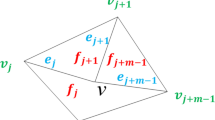Abstract
Tool postures of the flat-end cutter can make a huge difference to both machining strip width and machining efficiency in five-axis end milling. Most of current methods evaluate the machining strip width and implement a tool orientation optimization by finding two intersection points between the effective cutting profile of a flat-end cutter and the offset surface profile which represents machined surface. However, real machining strip width and real residual height should be formed between two adjacent cutter contours. As the results, two problems of current methods cannot be avoided: (1) Machining strip width computed on a single cutter location cannot accurately represent the distance between two adjacent tool paths and (2) excessive overlap or larger span length between two adjacent cutter contours leads to unsteady residual height, which causes surface quality differences. In order to solve the above problems, a more suitable method for computing machining strip width is presented and proved in this paper. A flat-end cutter is adopted and the analytical model of effective cutting shape for this kind of tool is constructed firstly. Later, a geometric foundation to achieve optimization is established by investigating the impact of different flat-end cutter postures on the machining strip width. Furthermore, the reasonable strip width is obtained and optimized by implementing an iterative and optimization approach under the given scallop height. A three-dimensional centrifugal compressor blade is used as a numerical example to verify the approach presented in this paper. To prove the superiority of the involved method, the research gives a comparison with UG method with the same cutting parameters. Numerical experiment suggests that machining efficiency of the paper’s method improves by 37.85%. Finally, a machining simulation is performed in the VERICUT software to testify that a uniform error distribution is created.
Similar content being viewed by others
References
He Y, Chen Z, Xu R, Wu X (2016) Reducing fluctuation of machining strip width by tool position modification for five-axis NC machining of sculptured surfaces. Int J Adv Manuf Technol 78(1–4):249–257
Ziran X, Gao L, Hussain G, Cui Z (2010) The performance of flat end and hemispherical end tools in single-point incremental forming. Int J Adv Manuf Technol 46:1113–1118
Gan Z, Chen Z, Zhou M (2016) Optimal cutter orientation for five-axis machining based on mechanical equilibrium theory. Int J Adv Manuf Technol 84(5–8):989–999
Javad Barakchi Fard M, Feng H-Y (2009) Effect of tool tilt angle on machining strip width in five-axis flat-end milling of free-form surfaces. Int J Adv Manuf Technol 44(34):211–222
Fan J, Ball A (2014) Flat-end cutter orientation on a quadric in five-axis machining. Comput Aided Des 53(5):126–138
Hu G, Fang FZ, Hu XT, Cao LX, Liu J (2010) Optimization of tool positions locally based on the BCELTP for 5-axis machining of free-form surfaces. Comput Aided Des 42(6):558–570
Warkentin A, Ismail F, Bedi S (2000) Multi-point tool positioning strategy for 5-axis machining of sculptured surfaces. Comput Aided Geom Des 17(1):83–100
Fan W, Wang X, Cai Y (2012) Rotary contact method for 5-axis tool positioning. J Manuf Sci Eng 134(2):021004
He Y, Chen Z (2014) Optimising tool positioning for achieving multi-point contact based on symmetrical error distribution curve in sculptured surface machining. Int Adv Manuf Technol 73(5):77–714
Fard MJB, FengH Y (2010) Effective determination of feed direction and tool orientation in five-axis flat-end milling. J Manuf Sci Eng 132(6):061011
Lu YA, Ding Y, Zhu LM (2016) Simultaneous optimization of the feed direction and tool orientation in five-axis flat-end milling. Int J Prod Res 54(15):1–10
Lu AY, Ding Y, ZhuLi M (2016) Tool path generation via the multi-criteria optimization for flat-end milling of sculptured surfaces. Int J prod Res: 1–22
Liu X, Li Y, Ma S, Lee CH (2015) A tool path generation method for freeform surface machining by introducing the tensor property of machining strip width. Comput Aided Des 66:1–13
Lee YS, Ji H (1997) Surface interrogation and machining strip evaluation for 5-axis CNC die and mold machining. Int Prod Res 35(1):225–252
Luo M, Yan DX, Wu BH, Zhang DH (2016) Barrel cutter design and toolpath planning for high-efficiency machining of freeform surface. Int J Adv Manuf Technol 85(9–12):2495–2503
Li LL, Zhang YF, Li HY, Geng L (2011) Generating tool-path with smooth posture change for five-axis sculptured surface machining based on cutter’s accessibility map. Int J Adv Manuf Technol 53(5–8):699–709
Lee YS (1998) Adaptive tool path planning for 5-axis sculptured surface machining by machining strip evaluation. International Conference on Machining Impossible Shapes 18: 351–361
Padberg M (1999) Analytical geometry [M]// Linear optimization and extensions 121–238
Gray PJ, Ismail F, Bedi S (2004) Graphics-assisted rolling ball method for 5-axis surface machining. Comput Aided Des 36(7):653–663
Author information
Authors and Affiliations
Corresponding author
Rights and permissions
About this article
Cite this article
Wu, B., Liang, M., Zhang, Y. et al. Optimization of machining strip width using effective cutting shape of flat-end cutter for five-axis free-form surface machining. Int J Adv Manuf Technol 94, 2623–2633 (2018). https://doi.org/10.1007/s00170-017-0953-2
Received:
Accepted:
Published:
Issue Date:
DOI: https://doi.org/10.1007/s00170-017-0953-2




